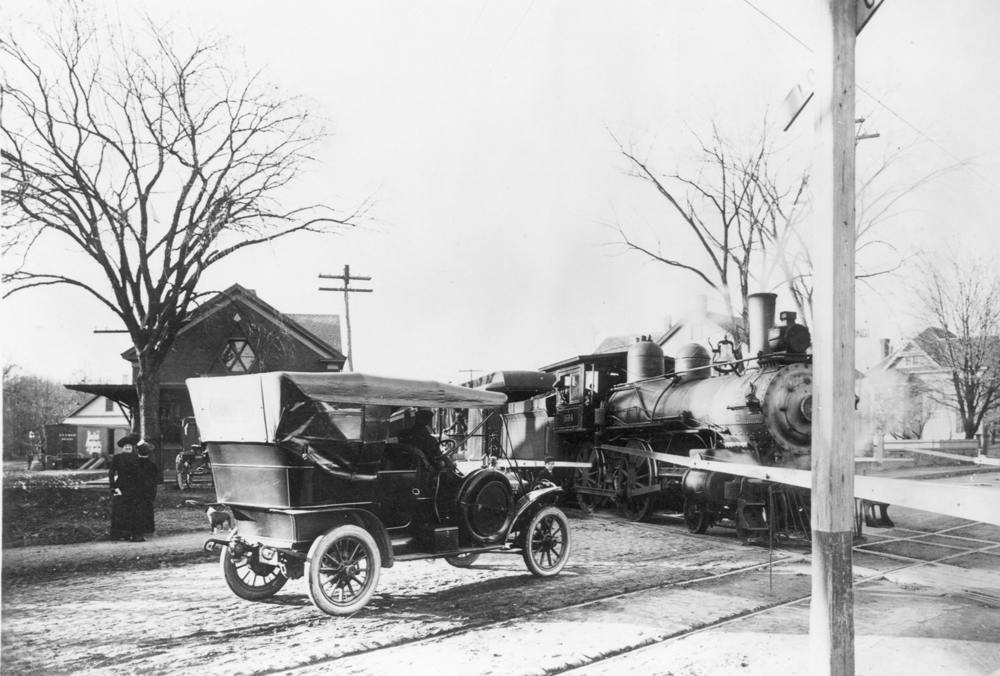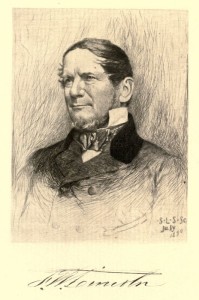True Tales from Canton’s Past: Spur Line
By George T. Comeau
Canton Center rail crossing with Canton Station (left), now the MBTA parking lot in Canton Center (Courtesy of the Canton Historical Society)
Perhaps the greatest joy of living in Canton is that it still sits with one foot in the past and one foot firmly in the now. There are anachronistic reminders of yesteryear if you know where to look. As you pass over the railroad tracks at Canton Center, heading north towards Memorial Hall, take a look just to the right. There it is, a granite pillar, engraved with the distance from that point to Providence, Rhode Island. It has been there for so long that few if any know of the origin story. But the fact that it sits next to the Stoughton Branch Line is no coincidence.
After the railroad came through Canton in 1834, the town was blessed with a marked growth. The population stood at 1,515 before the Viaduct was built, and in less than 10 years 400 people moved into town. Between the 1830s and 1870, the town added close to 2,500 people. It was a period of sustained growth that was built largely by immigrant labor and the expanding factories that were part of American ingenuity.
The railroad we know today is predominantly the same as it was almost 200 years ago. The rail route established through Canton by virtue of the dominant role played by Joseph Warren Revere was further cemented by Frederick Walker Lincoln and the role he played in expanding the railroad into Stoughton and beyond. One of the driving forces behind the expansion of the rail was the need to connect the Revere and Sons Copper Rolling Mill with the Kinsley Iron Works at what was then known as South Canton.
Many of the institutions that survive today owe much to both Kinsley and Revere. Our local banks have roots in both companies; the foundation of the Catholic Church in Canton is connected; and the Viaduct as a National Historic Site — all can be traced to the construction of the railroad and these two firms.
The Stoughton Branch Line was started in the summer of 1844. The company that began the enterprise was founded by a handful of men, Lyman Kinsley and Fredrick Walker Lincoln perhaps the two most prominent. Both men had deep connections in the fledgling industries that were shaping the American industrial machine.
Lincoln was a remarkable son of Canton. His father, Amos, was a descendant of Samuel Lincoln, who came to Salem from Norwich, England, in 1637, subsequently removing to Hingham. Amos was a conspicuous leader in the destruction of tea from British ships in Boston Harbor, and captain of an artillery company in the Revolutionary War. Lincoln was raised here in Canton and pretty much adopted by his grandfather, Paul Revere.
Fredrick Walker Lincoln was born in Boston on June 12, 1796, the son of Amos Lincoln and Deborah Revere, Paul’s eldest daughter. Following his mother’s death in April 1797, the infant was taken into Paul Revere’s family, where he remained until Revere died in 1818. A year later, in August 1819, he married Amelia Howard from Boston. Lincoln prospered here, and received his business education with the firm of Paul Revere & Son, continuing to run the company with Revere’s son, Joseph Warren, after the elder Revere’s death. Upon the establishment of the Revere Copper Company, he was placed in charge of the works as resident agent. During this time, in 1836, he was elected the first president of the Neponset Bank.
These were still the fledgling years of the railroad, and Lincoln was building a new railroad through the center of town. The legislature had authorized the incorporation with the issuance of $150,000 of capital stock. The route had been surveyed, and soon after the road definitely located in 1845. The first report stated that it “diverges from the Boston and Providence Rail-road at the Canton depot, passes about 200 yards to the east of Kinsley’s forge; crosses the upper end of Franklin Bisby’s (forge) pond; passes about 100 yards to the west of the widow Polly Bird’s house; and terminates in the rear of the orthodox meeting-house, in the village of Stoughton, being just four miles in length. The steepest ascent is 45 feet per mile, and the curvatures, except those at each end of the road, not less than 1830 feet radius.”
A contract was made with the Boston & Providence Railroad (which operated the main line) for the purposes of providing the rolling stock, and to keep the rail bed in good repair. Local historian Edward Galvin wrote in his definitive history of the railroad in Canton, “From an economic standpoint, the Stoughton Branch was divided equally between passenger and freight.” This author has long argued that the first railroad spur in America was the one through the Revere Copper Company. The second may very well have been the spur through the Kinsley Iron Works.
What became of the Kinsley Iron Works proper is now thoroughly obliterated. John Marini demolished the last remaining vestige of the original axle shop in 2000 with the construction of the Forge Pond Condominiums. The bright new complex has little reference to the company that literally built the western expansion of the American rail system.
Pretty much everything associated with this time in our history has most recently been destroyed at the hands of developers. They called it progress as it obliterated these historic sites. Sadly, with the construction of the new townhouses on Ames Avenue, we just lost remnants of a retaining wall that was built in 1844. Previously, we lost the Leland-Grimes house at 24 Ames Avenue that dated to 1848, as well as the Beasley House, Seavey-Daly House, the Pesaturo Garages, the Horton Building, the O’Dea House, and the freight office on Washington Street. Today, these are all luxury condominiums that will one day be torn down to make way for whatever is in vogue in the 22nd century.
There are a few “ghost” vestiges, however. Just outside the post office parking lot lies a small section of embedded tracks below the pavement. And a few foundations are now retaining walls in the neighborhood. Some of the beautiful granite has found other uses as well. There are other small vestiges known to the author.
Another lost piece of Canton’s architectural history is the railroad station at Canton Center. The original station was built in 1844-45 and there are no known images of this station. In 1878, the town passed a resolution requesting that the Boston & Providence Railroad build a new station. The railroad responded, “They were cutting expenses because of business receipts falling off.” Galvin writes, “There was concern that there was very little land to build upon. The railroad owned very little land in that neighborhood, for when the original South Canton depot had been built it was regarded as being a great distance out of town. Now that the population center of the town had shifted, the desire for a substantial station at South Canton became a major concern to Canton’s people.”
By 1880 a new station was built. This station served Canton until it was abandoned in 1949. The building was demolished in 1959.
Short URL: https://www.thecantoncitizen.com/?p=35031











